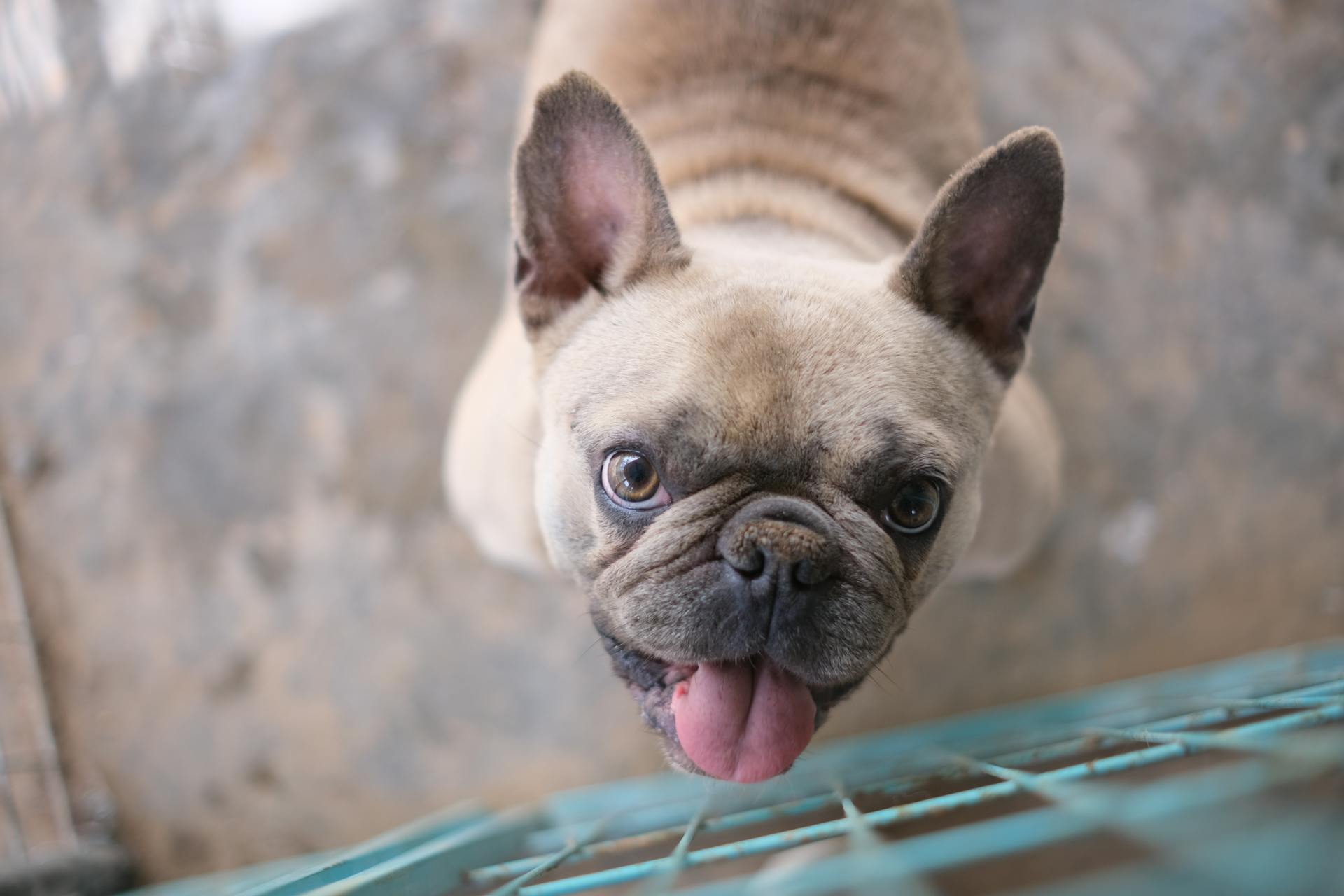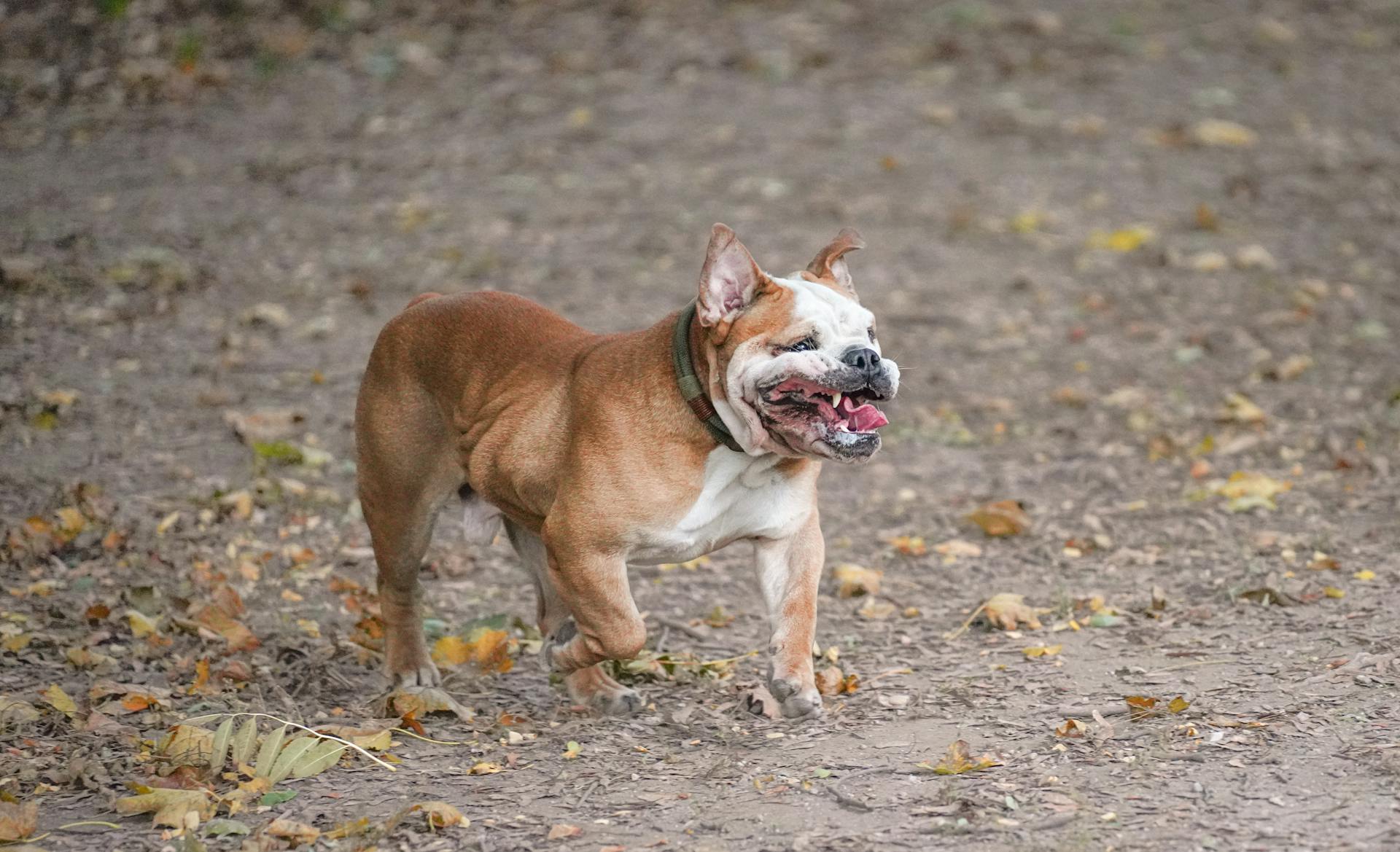
English Bulldogs are prone to hot spots, which can be a real challenge for owners.
Hot spots are painful, red, and inflamed areas on the skin that can quickly become infected if left untreated.
Caused by allergies, skin infections, or irritation, hot spots can appear anywhere on the body, but are most common on the face, neck, and legs.
To prevent hot spots, keep your English Bulldog's skin clean and dry, and trim their coat regularly to reduce hair accumulation.
Symptoms and Signs
English bulldogs can be prone to hot spots, which are painful and itchy areas of redness, swelling, and hair loss. These hot spots can occur anywhere on their body, but are most commonly seen on the head, limbs, and hips.
Redness and swelling are the first noticeable signs of hot spots in English bulldogs. They may also exhibit excessive licking or biting at the affected area.
The skin around the hot spot becomes moist and may discharge pus or fluid, leading to crusting and matting of the surrounding fur or hair. This can be a sign that your English bulldog is suffering from a hot spot.
Take a look at this: Spotted French Bulldogs
Some common signs of hot spots in English bulldogs include:
- Redness
- Swelling
- Hair loss
- Excessive licking or biting
- Itching
The hot spot lesion can range in size, but it's usually red, inflamed, and raw, and may bleed intermittently. This is due to the moist and painful skin, which can spread due to licking, chewing, and/or scratching.
Causes and Prevention
English bulldogs are prone to hot spots, and understanding the causes is key to prevention. Flea bites, skin allergies, and dirty coats are common triggers.
Flea bites and flea allergy dermatitis are two of the most common causes of hot spots in English bulldogs. Regular flea prevention is essential to prevent this. Dirty coats and matting can also lead to hot spots, making regular grooming crucial.
Some breeds, including English bulldogs, are more prone to hot spots due to their thick coats. Keeping their coats clean and well-groomed can help reduce the risk. Additionally, ensuring they dry off quickly after swimming or bathing is also important.
For more insights, see: English Bulldog Bites
Here are some common causes of hot spots in English bulldogs:
- Flea bites
- Atopic dermatitis
- Dirty coat or matting
- Ear infections
- Skin infections
- Food allergies
- Environmental allergies
- Stress, anxiety, or boredom leading to excessive licking
- Injuries and grazes
- Excess moisture in the coat after swimming or bathing
By understanding these causes and taking preventative measures, you can help reduce the risk of hot spots in your English bulldog.
What Causes Hot Spots?
Hot spots on dogs can develop from a variety of causes, including skin allergies, flea bites, and even minor grazes. Identifying the underlying cause is crucial to preventing future skin problems.
Some common causes of hot spots include skin infections, ear infections, and food allergies. These conditions can lead to a self-perpetuating cycle of itching and scratching, making the area more irritated and itchy.
Dogs with thicker coats, such as Golden Retrievers, German Shepherds, and Labradors, are more prone to developing hot spots due to excess moisture held against the skin. This is especially true during warm weather and periods of high humidity.
Other factors that can contribute to hot spots include dirty coats, matting, and excessive licking caused by stress, anxiety, or boredom. These conditions create the perfect environment for bacteria to take hold and cause infection.
Here are some common causes of hot spots in dogs:
- Flea bites
- Atopic dermatitis
- Dirty coat or matting
- Ear infections
- Skin infections
- Food allergies
- Environmental allergies
- Excess moisture in the dog’s coat after swimming or bathing
- Injuries and grazes
Prevention Methods

Preventing hot spots on dogs requires a multi-faceted approach. By keeping your dog's skin healthy, you can reduce the risk of infections.
Regular grooming is essential, especially after swimming or bathing. This helps prevent moisture from getting trapped close to the skin. Clipping long coats, especially in hot weather, can also help prevent hot spots.
Flea prevention is crucial, as fleas can cause skin irritation and lead to hot spots. Use a reliable flea control medication, even during the cold months.
Maintaining good hygiene, including regular ear cleaning, can also help prevent hot spots. This is especially important for dogs that swim or are frequently bathed.
In some cases, preventing boredom with interactive toys can help reduce excess licking behaviors that can lead to hot spots. For dogs that suffer from allergies, managing these allergies is also vital.
Using fatty acid supplements, such as fish oil, can help promote a healthy skin barrier and reduce inflammation. Consult with your vet to determine the best supplement for your dog.
Consider reading: Dogs Similar to English Bulldog

Here are some key prevention methods:
- Keep your dog's fur well-groomed and, if needed, trimmed.
- Make sure your dog is completely dry after a bath or being wet to prevent trapped moisture.
- Keep them on a flea control/heartworm prevention medicine, even during the cold months.
- Manage any allergies your dog may have.
- Use fatty acid supplements, such as fish oil, to promote a healthy skin barrier.
Home Remedies and Care
If you're dealing with an English bulldog hot spot, it's essential to keep the area clean and dry to promote healing.
Use a mild, water-based antiseptic spray or wipe to clean the skin, or an antibacterial shampoo if the hot spot is covered in fur.
Topical creams and ointments should be avoided, as they can cause your dog to lick the area even more.
Trim the fur around the hot spot with dog hair clippers, not scissors, to prevent accidentally cutting your pet's skin.
Apply a veterinary-recommended hot spot spray for dogs that is safe if ingested.
To prevent further irritation, place a recovery cone on your dog to keep them from biting, licking, or scratching the hot spot.
Monitor the area for signs of healing, such as decreased redness, less moisture, and a smaller lesion size.
Here are the steps to promote healing of the hot spot in a concise list:
- Trim the fur around the hot spot with dog hair clippers.
- Clean the skin with a mild, water-based antiseptic spray or wipe.
- Apply a veterinary-recommended hot spot spray for dogs.
- Place a recovery cone on your dog to prevent further irritation.
- Monitor the area for signs of healing.
By following these steps, you can help your English bulldog's hot spot heal before your vet appointment.
Veterinary Care and Costs
Hot spot treatment costs can vary greatly depending on the severity of the lesion and how often it recurs. If the lesions are uncomplicated and only appear once or twice a year, treatment can range from $40 to $200.
More comprehensive diagnostic tests, such as allergy testing, can increase the expense significantly, with costs reaching up to $2,000.
You might like: English Bulldog Hip Dysplasia Treatment
When to Seek Veterinary Care
If your dog's hot spot doesn't improve, gets worse, or spreads to other areas, it's crucial to seek veterinary care as soon as possible. Approximately 30% of dogs with hot spots will have some form of skin disease that requires veterinary treatment.
Your vet will perform a full physical exam and may recommend additional tests, such as an allergy panel or skin scrape to check for parasites. This is to diagnose the underlying cause of the hot spot.
Most vets treat hot spots with topical medication to control inflammation and decrease itching, and oral antibiotics to treat secondary bacterial infections. This is usually a combination of treatments.
Your vet might also prescribe medicated solutions, wipes, or hot spot sprays to gently clean the affected area daily. This helps prevent further irritation and promotes healing.
Depending on the underlying cause, additional medications might be necessary to treat conditions like allergies, ear infections, or flea infestations.
Discover more: English Bulldog Vet
Costs
Veterinary care can be expensive, but understanding the costs can help you prepare for your pet's needs. The cost of diagnosing and treating hot spots on dogs can range from $40 to $200, depending on the severity of the lesion and how often it recurs.
If more comprehensive diagnostic tests are required, the expense will increase significantly. In some cases, allergy testing can cost up to $2,000.
No matter what type of veterinary treatment your pet needs, vet bills can be a significant financial burden.
Consider reading: English Bulldog Insurance
Prevention and Maintenance
Keeping your English Bulldog's skin healthy is the first step towards preventing hot spots. Regular grooming is essential, especially after swimming or bathing, to prevent moisture from getting trapped close to the skin.
Good hygiene and routine dog grooming can help prevent dog hot spots. This includes keeping your dog's fur well-groomed and, if needed, trimmed.
English Bulldogs are prone to skin fold dermatitis, so it's crucial to clean their skin folds regularly to prevent intertrigo. Wrinkly breeds like English Bulldogs need extra attention to keep their skin healthy.
A fresh viewpoint: Grooming an English Bulldog
Preventing flea infestations is also vital in preventing hot spots. Use a reliable flea control/heartworm prevention medicine, even during the cold months.
Making sure your dog is completely dry after a bath or being wet is essential to prevent trapped moisture. This is especially important for English Bulldogs with a double coat or long hair.
Here are some essential tips to prevent hot spots in English Bulldogs:
- Regular grooming and skin fold cleaning
- Preventing flea infestations
- Ensuring complete drying after baths or swimming
- Managing allergies and skin infections
- Using fatty acid supplements, such as fish oil, to promote a healthy skin barrier
Frequently Asked Questions
Will a dog hot spot go away on its own?
No, dog hot spots typically won't heal on their own and can worsen without proper care. Seek veterinary attention for timely treatment and quick recovery.
How to treat a bulldog skin infection?
Treat a bulldog skin infection with oral antibiotics and antibacterial shampoos or topical ointments, and be prepared for a treatment period of several weeks
What does a hotspot look like on a dog?
A hotspot on a dog typically appears as a red, swollen, and moist area with crusting, matting, and possible discharge, often found on the hips, limbs, and head. If you suspect a hotspot, it's essential to consult a veterinarian for proper diagnosis and treatment.
Sources
- https://www.petmd.com/dog/general-health/hot-spots-dogs
- https://www.akc.org/expert-advice/health/treating-and-preventing-hot-spots-on-dogs/
- https://www.purina.co.uk/articles/dogs/health/symptoms/dog-hot-spots
- https://www.pawlicy.com/blog/hot-spots-on-dogs/
- https://lavengel.com/pages/skin-issues-hotspots
Featured Images: pexels.com


